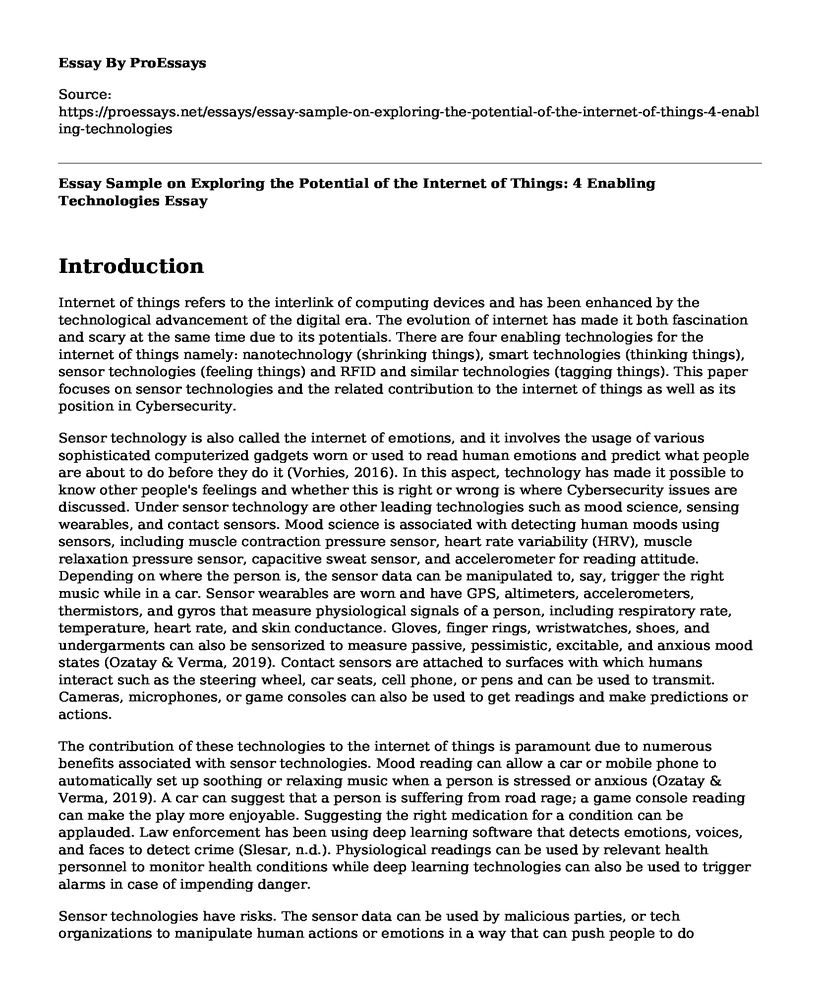Introduction
Internet of things refers to the interlink of computing devices and has been enhanced by the technological advancement of the digital era. The evolution of internet has made it both fascination and scary at the same time due to its potentials. There are four enabling technologies for the internet of things namely: nanotechnology (shrinking things), smart technologies (thinking things), sensor technologies (feeling things) and RFID and similar technologies (tagging things). This paper focuses on sensor technologies and the related contribution to the internet of things as well as its position in Cybersecurity.
Sensor technology is also called the internet of emotions, and it involves the usage of various sophisticated computerized gadgets worn or used to read human emotions and predict what people are about to do before they do it (Vorhies, 2016). In this aspect, technology has made it possible to know other people's feelings and whether this is right or wrong is where Cybersecurity issues are discussed. Under sensor technology are other leading technologies such as mood science, sensing wearables, and contact sensors. Mood science is associated with detecting human moods using sensors, including muscle contraction pressure sensor, heart rate variability (HRV), muscle relaxation pressure sensor, capacitive sweat sensor, and accelerometer for reading attitude. Depending on where the person is, the sensor data can be manipulated to, say, trigger the right music while in a car. Sensor wearables are worn and have GPS, altimeters, accelerometers, thermistors, and gyros that measure physiological signals of a person, including respiratory rate, temperature, heart rate, and skin conductance. Gloves, finger rings, wristwatches, shoes, and undergarments can also be sensorized to measure passive, pessimistic, excitable, and anxious mood states (Ozatay & Verma, 2019). Contact sensors are attached to surfaces with which humans interact such as the steering wheel, car seats, cell phone, or pens and can be used to transmit. Cameras, microphones, or game consoles can also be used to get readings and make predictions or actions.
The contribution of these technologies to the internet of things is paramount due to numerous benefits associated with sensor technologies. Mood reading can allow a car or mobile phone to automatically set up soothing or relaxing music when a person is stressed or anxious (Ozatay & Verma, 2019). A car can suggest that a person is suffering from road rage; a game console reading can make the play more enjoyable. Suggesting the right medication for a condition can be applauded. Law enforcement has been using deep learning software that detects emotions, voices, and faces to detect crime (Slesar, n.d.). Physiological readings can be used by relevant health personnel to monitor health conditions while deep learning technologies can also be used to trigger alarms in case of impending danger.
Sensor technologies have risks. The sensor data can be used by malicious parties, or tech organizations to manipulate human actions or emotions in a way that can push people to do particular actions (Ozatay & Verma, 2019). Determining the motive behind some technologies can be daunting, and data scientists should worry about this one. Cybercriminals can get access to such private data and use it to target or attack individuals in various ways.
Conclusion
In conclusion, diverse fields such as medicine, robotics, advertising, gaming, virtual reality, and education, among others, can benefit greatly benefit from the internet of things like emotion-sensing technology. Strategic planners can utilize this technology to not only build but also market their products. At the same time, cybercriminals can also take advantage of the vast data and use it against individuals to commit cyber attacks. Adequate cybersecurity protocols need to be followed to minimize loopholes that can be exploited by cybercriminals.
References
Ozatay, M., & Verma, N. (2019). Exploiting Emerging Sensing Technologies Toward Structure in Data for Enhancing Perception in Human-Centric Applications. IEEE Internet Of Things Journal, 6(2), 3411-3422. doi: 10.1109/jiot.2018.2883905
Slesar, M. Emotion-Sensing Technology in the Internet of Things. Retrieved 5 September 2019, from https://onix-systems.com/blog/emotion-sensing-technology-in-the-internet-of-things
Vorhies, W. (2016). These IoT Sensors Want to Know How You Feel - And Maybe Even Change Your Mood. Retrieved 5 September 2019, from https://www.datasciencecentral.com/profiles/blogs/these-iot-sensors-want-to-know-how-you-feel-and-maybe-even-change
Cite this page
Essay Sample on Exploring the Potential of the Internet of Things: 4 Enabling Technologies. (2023, Feb 09). Retrieved from https://proessays.net/essays/essay-sample-on-exploring-the-potential-of-the-internet-of-things-4-enabling-technologies
If you are the original author of this essay and no longer wish to have it published on the ProEssays website, please click below to request its removal:
- Innovations in Social Investments and its Future, Essay Example
- If Computers Can Understand Images the Same Way Human Brains Do Paper Example
- Visions of the Ubiquitous Network Society Essay Example
- Essay Sample on Nanotechnology and Robo-Taxis
- Essay Sample on Driverless Cars: The Future of Shared Transportation
- Advancement of Information Systems & Technology: AI in the 21st Century - Essay Sample
- Paper Sample on McDonald's: A Global Success Story of 30k Stores and 15bn Incomes







